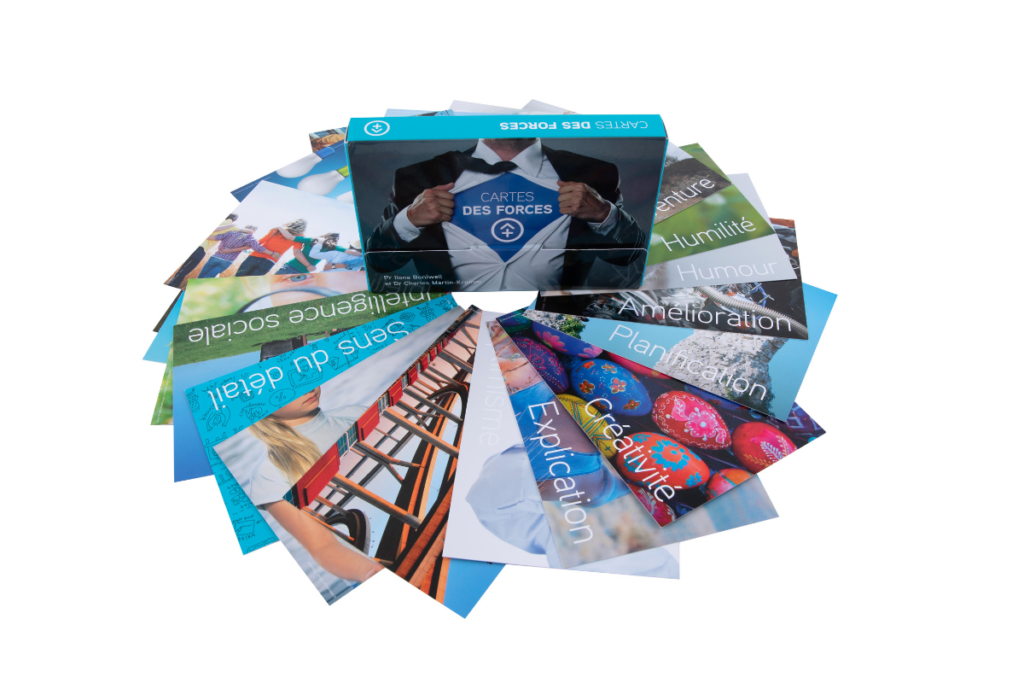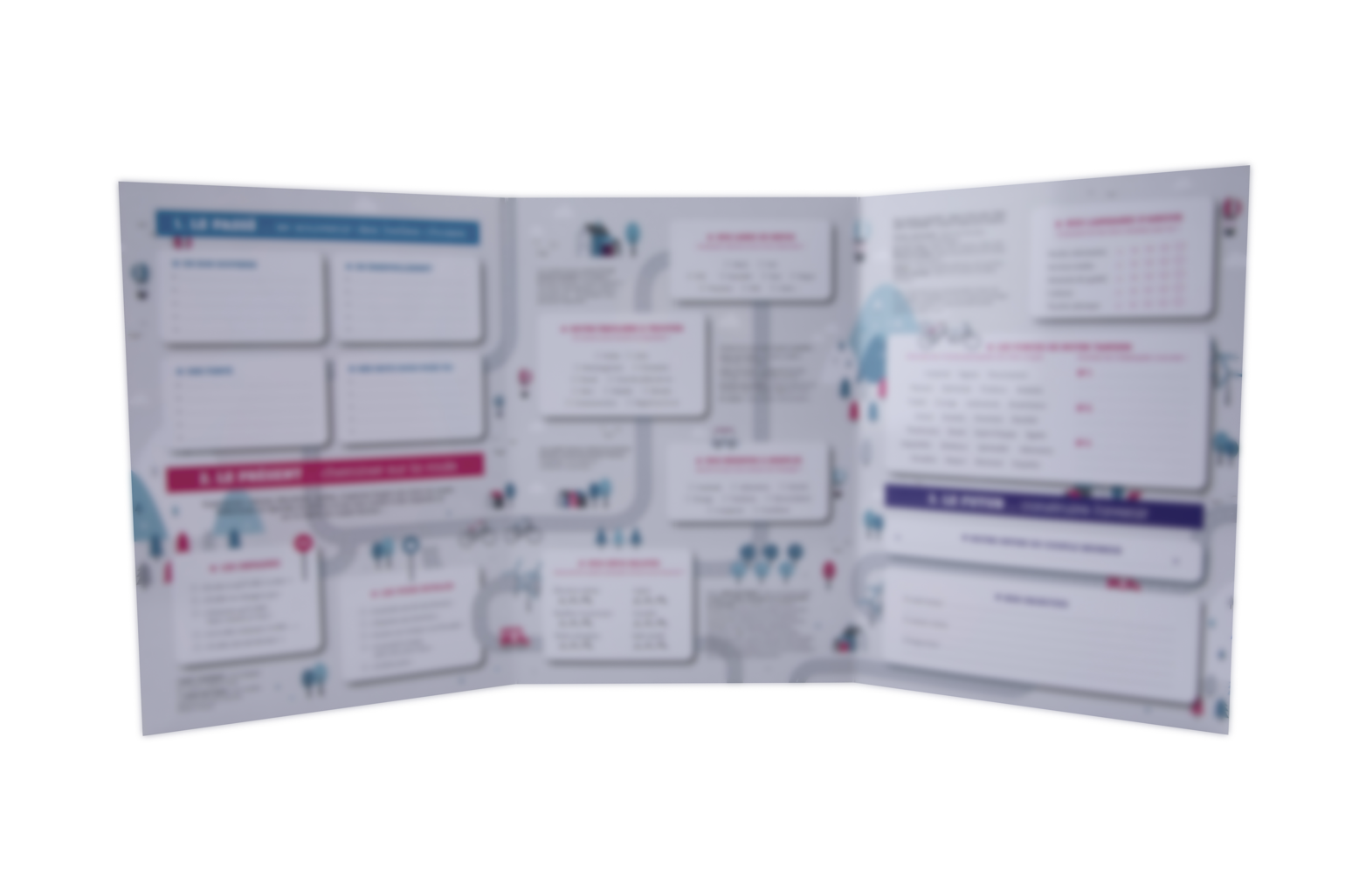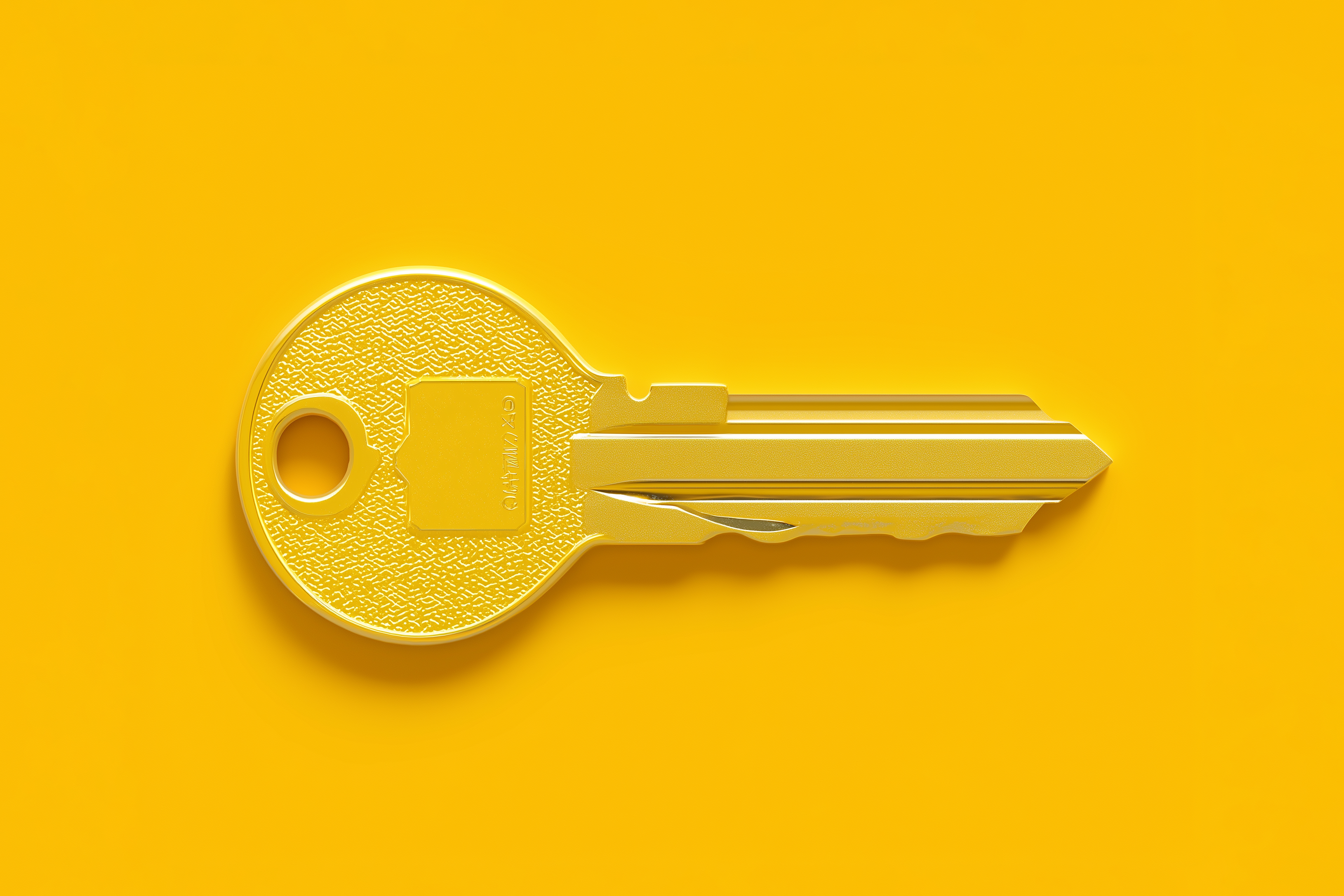
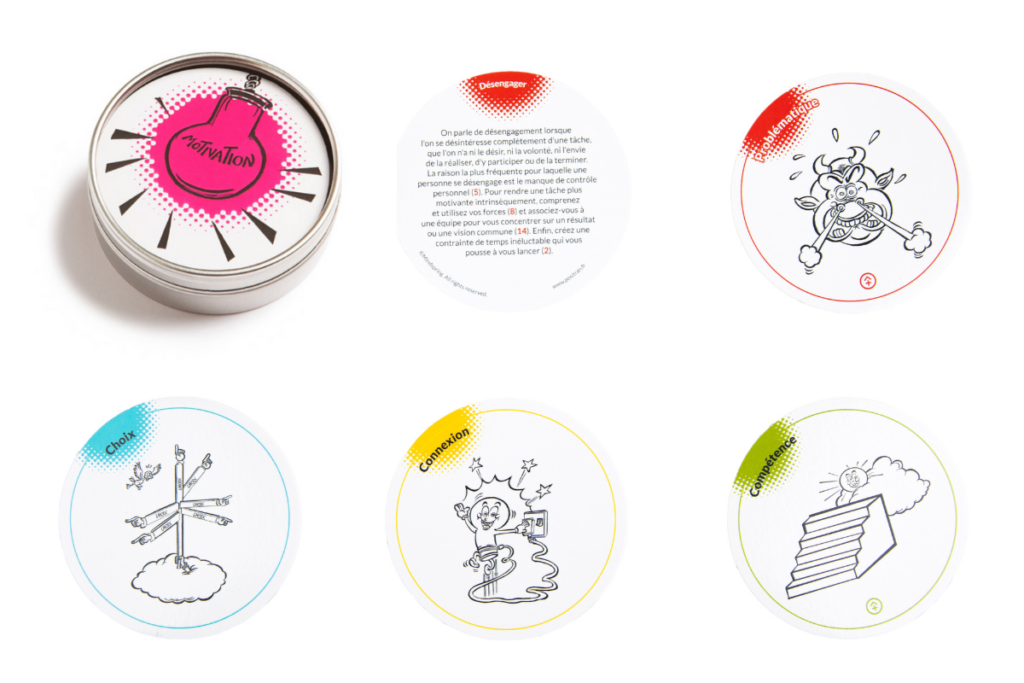
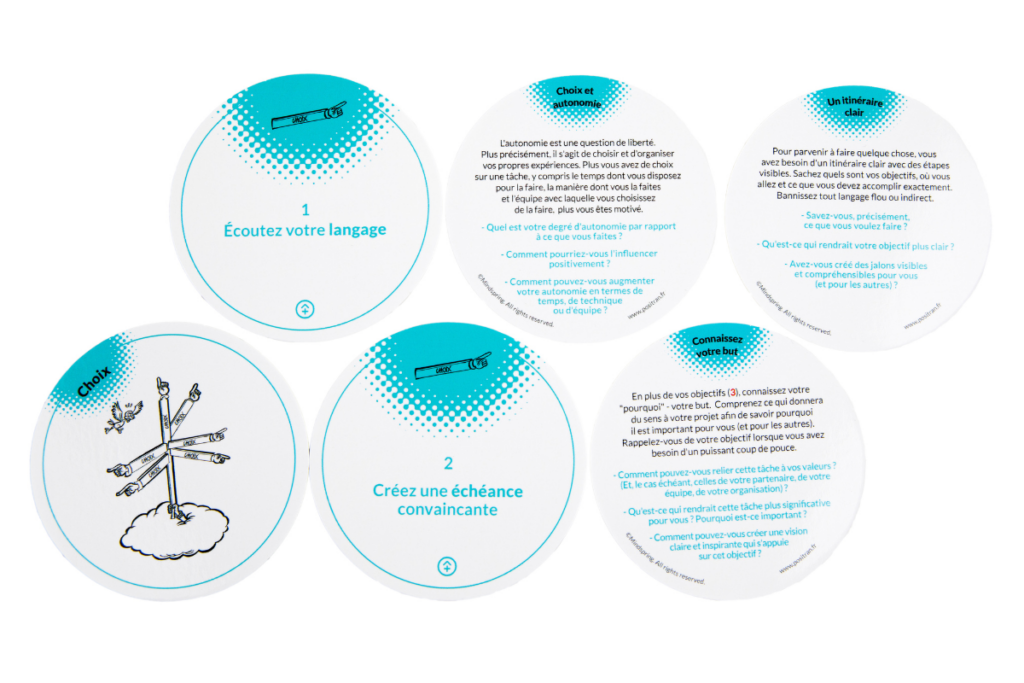

Motivation Cards
Based on science, the Motivation Cards (Mindspring) offer you an interactive way to understand why someone might feel demotivated and offer 15 scientifically proven methods to increase motivation.
Motivation is what allows us to pursue an activity with the goal of achieving personal satisfaction. While you may sometimes find it easy to move forward on your own, you may also encounter difficulties or even dead ends.

Product Description
Motivation is what allows us to pursue an activity with the goal of achieving personal satisfaction. While you may sometimes find it easy to move forward on your own, you may also encounter difficulties or even dead ends.
The 10 problem cards allow you to identify your obstacles in moving forward with your projects. On the back of each card, you will be redirected to the motivation cards.
The 15 Motivation Cards explain 15 scientifically proven actions to boost your motivation and which meet the three fundamental needs identified by motivation research (Deci & Ryan, 1985): Choice, Competence, Connection.
Here are the leading scientists who have explored motivation in depth. We've distilled their work into the 15 techniques you have on your cards:
– Self-determination theory – Deci and Ryan
– Flow – Mihalyi Csikszentmihalyi
– Personal Effectiveness – Albert Bandura
– Positive Emotions – Barbara Frederickson
– Mindset – Carol Dweck
– Progress – Amabile and Kramer
– Goal Theory – Edwin Locke
– Positive psychology and optimism – Martin Seligman
To go further
Read more about the research behind the game.
Train yourself in intrinsic motivation .
Who is it for?
Motivation Cards are designed to facilitate your coaching and training.
We use them in a variety of situations in training and coaching.
This is clearly about motivation and goal setting, but also about implementing action plans, making life and career choices, dealing with feelings of being stuck or procrastinating, improving commitment, dealing with setbacks, leading and motivating a team, dealing with self-doubt, accepting others, or boosting morale.
Its use
Tips for using Motivation Cards:
1. Start by familiarizing yourself with the cards. Think about the different goals you have had, the different strategies that have worked for you, and explore how they relate to the cards. Think about the obstacles you have faced and how they relate to the Problem cards. This will give you plenty of examples and case studies to discuss with your clients;
2. In a general discussion about motivation, commitment, and goal setting, present the 15 cards and review each one as a way to understand and accelerate motivation;
3. You can also give the cards to the person and allow them to flip through them themselves. This allows them to take ownership of the process and be independent;
4. Explain that there is a difference between Motivation Choice (getting started and being clear about where you're starting), Competence (making progress and dealing with setbacks), and Connection (making deeper connections to help you along the way). Use these differences to inspire a deeper conversation about motivation;
5. As you go through the 15 solution cards, you will notice that certain techniques appeal to different people. Focus on the cards that resonate and have a discussion about how to make this method more relevant and useful in their lives and work;
6. Many people begin a discussion about motivation by asking themselves what’s wrong or why they don’t have it (e.g., “I’m stuck,” “I’m procrastinating”). In this case, start with the Problem cards – the 10 most common reasons people feel unmotivated. Ask the person to choose the Problem card that best fits their feelings or situation and explore possible solutions on the back of the cards;
7. When someone is facing a particular goal, you can use the cards as a catalyst for a coaching discussion about how to get started, what to do to maintain momentum, and what support the person might need. This will allow the person (or team) to establish a specific action plan within a short period of time;
8. Cards work very well with a team. Taking one goal at a time, have the team work through the cards (in pairs or teams) and come up with specific strategies to achieve that goal;
9. Prioritize strategies;
10. Keeping the same objective, ask the team to explore problem cards that might hinder progress on an objective and ensure that the priority list above seems accurate to the team;
11. Develop a specific action plan with the team;
12. If a team is lacking engagement or needs a boost, use the cards to honestly explore why this is and what everyone can do differently to boost morale;
13. Connect the cards to the motivation ladder and discuss where the team or individual is on the motivation ladder and how they can improve;
14. Make the cards visible in the workplace – ask people to stick them next to their goal(s) and check them off as they get closer to their goal!
15. Give people the category cards (issues, choices, skills, connection) as a reminder of your session and to maintain motivation.
Motivation is what allows us to pursue an activity with the goal of achieving personal satisfaction. While you may sometimes find it easy to move forward on your own, you may also encounter difficulties or even dead ends.
The 10 problem cards allow you to identify your obstacles in moving forward with your projects. On the back of each card, you will be redirected to the motivation cards.
The 15 Motivation Cards explain 15 scientifically proven actions to boost your motivation and which meet the three fundamental needs identified by motivation research (Deci & Ryan, 1985): Choice, Competence, Connection.
Here are the leading scientists who have explored motivation in depth. We've distilled their work into the 15 techniques you have on your cards:
– Self-determination theory – Deci and Ryan
– Flow – Mihalyi Csikszentmihalyi
– Personal Effectiveness – Albert Bandura
– Positive Emotions – Barbara Frederickson
– Mindset – Carol Dweck
– Progress – Amabile and Kramer
– Goal Theory – Edwin Locke
– Positive psychology and optimism – Martin Seligman
To go further
Read more about the research behind the game.
Train yourself in intrinsic motivation .
Motivation Cards are designed to facilitate your coaching and training.
We use them in a variety of situations in training and coaching.
This is clearly about motivation and goal setting, but also about implementing action plans, making life and career choices, dealing with feelings of being stuck or procrastinating, improving commitment, dealing with setbacks, leading and motivating a team, dealing with self-doubt, accepting others, or boosting morale.
Tips for using Motivation Cards:
1. Start by familiarizing yourself with the cards. Think about the different goals you have had, the different strategies that have worked for you, and explore how they relate to the cards. Think about the obstacles you have faced and how they relate to the Problem cards. This will give you plenty of examples and case studies to discuss with your clients;
2. In a general discussion about motivation, commitment, and goal setting, present the 15 cards and review each one as a way to understand and accelerate motivation;
3. You can also give the cards to the person and allow them to flip through them themselves. This allows them to take ownership of the process and be independent;
4. Explain that there is a difference between Motivation Choice (getting started and being clear about where you're starting), Competence (making progress and dealing with setbacks), and Connection (making deeper connections to help you along the way). Use these differences to inspire a deeper conversation about motivation;
5. As you go through the 15 solution cards, you will notice that certain techniques appeal to different people. Focus on the cards that resonate and have a discussion about how to make this method more relevant and useful in their lives and work;
6. Many people begin a discussion about motivation by asking themselves what’s wrong or why they don’t have it (e.g., “I’m stuck,” “I’m procrastinating”). In this case, start with the Problem cards – the 10 most common reasons people feel unmotivated. Ask the person to choose the Problem card that best fits their feelings or situation and explore possible solutions on the back of the cards;
7. When someone is facing a particular goal, you can use the cards as a catalyst for a coaching discussion about how to get started, what to do to maintain momentum, and what support the person might need. This will allow the person (or team) to establish a specific action plan within a short period of time;
8. Cards work very well with a team. Taking one goal at a time, have the team work through the cards (in pairs or teams) and come up with specific strategies to achieve that goal;
9. Prioritize strategies;
10. Keeping the same objective, ask the team to explore problem cards that might hinder progress on an objective and ensure that the priority list above seems accurate to the team;
11. Develop a specific action plan with the team;
12. If a team is lacking engagement or needs a boost, use the cards to honestly explore why this is and what everyone can do differently to boost morale;
13. Connect the cards to the motivation ladder and discuss where the team or individual is on the motivation ladder and how they can improve;
14. Make the cards visible in the workplace – ask people to stick them next to their goal(s) and check them off as they get closer to their goal!
15. Give people the category cards (issues, choices, skills, connection) as a reminder of your session and to maintain motivation.



